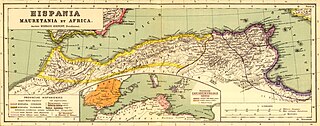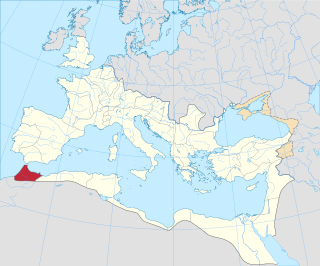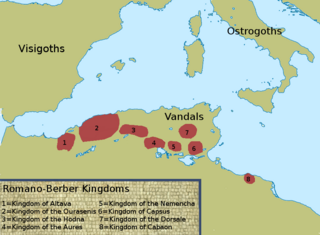
Mauretania is the Latin name for a region in the ancient Maghreb. It stretched from central present-day Algeria westwards to the Atlantic, covering northern present-day Morocco, and southward to the Atlas Mountains. Its native inhabitants, of Berber ancestry, were known to the Romans as the Mauri and the Masaesyli.

Mauretania Caesariensis was a Roman province located in what is now Algeria. The full name refers to its capital Caesarea Mauretaniae.

Mauretania Tingitana was a Roman province, coinciding roughly with the northern part of present-day Morocco. The territory stretched from the northern peninsula opposite Gibraltar, to Sala Colonia and Volubilis to the south, and as far east as the Mulucha river. Its capital city was Tingis, which is the modern Tangier. Other major cities of the province were Iulia Valentia Banasa, Septem, Rusadir, Lixus and Tamuda.

Kusaila was a 7th-century Berber Christian ruler of the kingdom of Altava and leader of the Awraba tribe, a Christianised sedentary Berber tribe of the Aures and possibly Christian king of the Sanhaja. Under his rule his domain stretched from Volubilis in the west to the Aurès in the east and later Kairouan and the interior of Ifriqiya. Kusaila is mostly known for prosecuting an effective Berber military resistance against the Muslim conquest of the Maghreb in the 680s. He died in one of those battles in 688.

Mauretania Sitifensis was a Roman province in Northwest Africa. The capital was Setifis.

The Praetorian Prefecture of Africa was an administrative division of the Byzantine Empire in the Maghreb. With its seat at Carthage, it was established after the reconquest of northwestern Africa from the Vandals in 533–534 by the Byzantine Emperor Justinian I. It continued to exist until 591, when it was replaced by the Exarchate of Africa.

Mauri was the Latin designation for the Berber population of Mauretania, located in the west side of North Africa on the shores of the Mediterranean Sea, Mauretania Tingitana and Mauretania Caesariensis, in present-day Morocco and northwestern Algeria.
Stotzas, also Stutias, Theophanes writes him Tzotzas (Τζότζας), was an East Roman (Byzantine) soldier and leader of a military rebellion in the Praetorian prefecture of Africa in the 530s. Stotzas attempted to establish Africa as a separate state and had been chosen by the rebelling soldiers as their leader. Nearly succeeding in taking Carthage, Stotzas was defeated at the Battle of the River Bagradas by Belisarius and fled into Numidia, where he regrouped. After another attempt at taking control of Africa, Stotzas was defeated by Germanus in 537 and fled with some of his followers into Mauretania.

Altava was an ancient Romano-Berber city in present-day Algeria. It served as the capital of the ancient Berber Kingdom of Altava. During the French presence, the town was called Lamoriciere. It was situated in the modern Ouled Mimoun near Tlemcen.

Caesarea in Mauretania was a Roman colony in Roman-Berber North Africa. It was the capital of Mauretania Caesariensis and is now called Cherchell, in modern Algeria. In the present time Caesarea is used as a titular see for Catholic and Eastern Orthodox bishops.
Solomon was an East Roman (Byzantine) general from northern Mesopotamia, who distinguished himself as a commander in the Vandalic War and the reconquest of North Africa in 533–534. He spent most of the next decade in Africa as its governor general, combining the military post of magister militum with the civil position of praetorian prefect. Solomon successfully confronted the large-scale rebellion of the native Berbers, but was forced to flee following an army mutiny in spring of 536. His second tenure in Africa began in 539 and it was marked by victories over the Berbers, which led to the consolidation of the Byzantine position. A few years of prosperity followed, but were cut short by the rekindled Berber revolt and Solomon's defeat and death at the Battle of Cillium in 544.
Masuna or Massonas was a Berber from what is now western Algeria who was said to have been a Christian, he ruled the Mauro-Roman Kingdom with its capital based in Altava which is now in present-day Algeria around the Tlemcen area. He was able to maintain the independence of his kingdom by resisting occupation from the Vandals. King Masuna allied with the Eastern Roman Emperor Justinian and assisted him in a war against the Vandals in 533 and also against other invading Berber tribal confederations. During his reign he was obeyed by the tribes of Mauretania.
Antalas was a Berber tribal leader who played a major role in the wars of the Byzantine Empire against the Berber tribes in Africa. Antalas and his tribe, the Frexes initially served the Byzantines as allies, but after 544 switched sides. With the final Byzantine victory in his and his tribe once again became Byzantine subjects. The main sources on his life are the epic poem Iohannis of Flavius Cresconius Corippus and the Histories of the Wars of Procopius of Caesarea.
Masties was the ruler of Kingdom of the Aurès, a Roman-Berber kingdom in Algeria.

The Kingdom of Altava was an independent Christian Berber kingdom centered on the city of Altava in present-day northern Algeria. The Kingdom of Altava was a successor state of the previous Mauro-Roman Kingdom which had controlled much of the ancient Roman province of Mauretania Caesariensis. During the reign of Kusaila, it extended from Volubilis in the west to the Aurès and later Kairaouan and the interior of Ifriqiya in the east. This Kingdom collapsed following Eastern Roman military campaigns to decrease its influence and power after Garmul invaded the Exarchate of Africa.

The Limes Mauretaniae was a portion of a 4,000-kilometre (2,500 mi) Roman fortified border (limes) in Africa approximately 100 kilometres (62 mi) south of the modern day Algiers.

The Mauro-Roman kingdom, also described as the kingdom of Masuna, was a Christian Berber kingdom which dominated much of the ancient Roman province of Mauretania Caesariensis from the capital city of Altava. Scholars are in disagreement about whether the polity aimed for independence as a kingdom or was part of a loose confederation, an alternative hypothesis drawn from contextual knowledge about Berber tribal alliances. In the fifth century, Roman control over the province weakened and Imperial resources had to be concentrated elsewhere, notably in defending the Roman Italy itself from invading Germanic tribes. Moors and Romans in Mauretania came to operate independently from the Empire. However, regional leaders may not have necessarily felt abandoned by the Romans.

The Kingdom of the Aurès was an independent Christian Berber kingdom primarily located in the Aurès Mountains of present-day north-eastern Algeria. Established in the 480s by King Masties following a series of Berber revolts against the Vandalic Kingdom, which had conquered the Roman province of Africa in 435 AD, Aurès would last as an independent realm until the Muslim conquest of the Maghreb in 703 AD when its last monarch, Queen Dihya, was slain in battle.
The Byzantine–Moorish wars were a series of wars fought between the Byzantine Empire and the various Berber kingdoms which formed after the collapse of Roman North Africa. The war also featured other rebels such as the renegades of Stotzas and the Vandalic rebels of Guntarith. The war ended with the Berbers attempting to push the Romans out of Africa being defeated at the battle of the Fields of Cato, and the Byzantines being too weakened to take over the various newly formed kingdoms such as Altava and the Kingdom of the Aurès.
Iaudas or Iabdas was a Berber leader of the sixth century and king of the Kingdom of the Aurès who held the Byzantines in check for a long time in the Aurès, and played an important role in the Berber revolts following the Byzantine reconquest.













